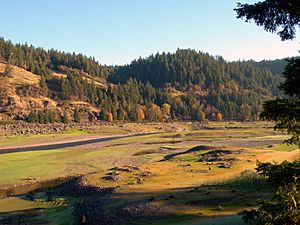Middle Fork Willamette River facts for kids
Quick facts for kids Middle Fork Willamette River |
|
|---|---|
 |
|

Map of the Willamette River watershed with the Middle Fork highlighted
|
|
|
Location of the mouth of the Middle Fork Willamette River in Oregon
|
|
| Country | United States |
| State | Oregon |
| Counties | Douglas and Lane |
| Physical characteristics | |
| Main source | Timpanogas Lake, Cascade Range 5,552 ft (1,692 m) 43°24′48″N 122°07′20″W / 43.41333°N 122.12222°W |
| River mouth | Willamette River between Eugene and Springfield 440 ft (130 m) 44°01′23″N 123°01′25″W / 44.02306°N 123.02361°W |
| Length | 115 mi (185 km) |
| Basin features | |
| Basin size | 1,340 sq mi (3,500 km2) |
| Tributaries | |
The Middle Fork Willamette River is a major river in Oregon, a state in the United States. It's one of the main branches that come together to form the larger Willamette River. This river flows for about 115 miles (185 km) and drains a large area in the Cascade Range mountains, southeast of the city of Eugene. The Middle Fork is an important part of the Willamette Valley's natural environment.
The River's Journey
The Middle Fork Willamette River begins in northeastern Douglas County. It's formed when many small streams, called headwaters, join together near a place called Emigrant Pass. From there, the river flows mostly north into Lane County. It travels through the Calapooya Mountains until it reaches the cities of Eugene and Springfield. Here, it meets another river, the Coast Fork Willamette River, and together they create the main Willamette River.
Dams and Reservoirs
As the Middle Fork flows, its path is changed by several dams. Just south of Oakridge, the river is held back by Hills Creek Dam. This dam creates a large body of water called Hills Creek Reservoir.
Below Hills Creek Dam, other streams join the Middle Fork. These include Salt Creek and Salmon Creek, which flows into the river at Oakridge. Further downstream, near Westfir, the North Fork Middle Fork Willamette River adds its waters to the Middle Fork.
After these rivers join, the Middle Fork is again held back by two more dams. These create Lookout Point Reservoir and Dexter Reservoir. Finally, Fall Creek joins the Middle Fork below Dexter Reservoir. The Middle Fork then flows a short distance before meeting the Coast Fork in Springfield to form the main Willamette River.
Streams that Feed the River
Many smaller streams, called tributaries, flow into the Middle Fork Willamette River along its journey. These streams add water to the river, making it bigger as it flows towards the Willamette.
- Some of the streams that join the Middle Fork before it reaches Hills Creek Reservoir include Beaver, Tumblebug, Royal, and Indigo creeks.
- Several streams also flow into Hills Creek Reservoir itself, such as Snow, Big Willow, and Hills creeks.
- After Hills Creek Reservoir, you'll find streams like Salt, Salmon, and Chillo creeks joining the river.
- The North Fork Middle Fork Willamette River is a significant tributary that adds a lot of water to the Middle Fork.
- Later, streams like Duval, South, and North creeks flow into Lookout Point Reservoir.
- Finally, before the Middle Fork meets the Coast Fork, streams like Lost Creek and Fall Creek contribute their waters.


